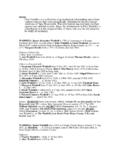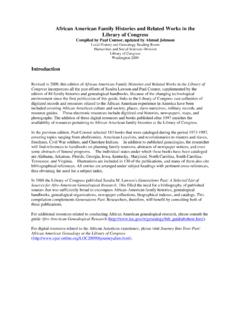Transcription of Belarus: Jewish Family History Research Guide
1 Courtesy of the Ackman & Ziff Family Genealogy Institute Revised July 2012 Ackman and Ziff Family Genealogy Institute Center for Jewish History 15 West 16th Street, New York, NY 10011 (212) 294 8318 belarus : Jewish Family History Research Guide Brief History The Grand Duchy of Lithuania, which united with the Kingdom of Poland in 1569, ruled most of Byelorussia ( White Russia ) until the reign of Catherine the Great in Russia (r. 1762-1796). Therefore, many Jews who identified themselves as Litvaks actually originated in shtetls located in belarus . Upon the First Partition of Poland in 1772, Russia acquired the Eastern portion of present-day belarus , including the towns of Vitebsk, Mogilev, and Gomel. The Second Partition in 1793 gave Minsk and the central region to Russia, and, in 1795, the Third Partition incorporated the remainder of Byelorussia into the Russian Empire.
2 Under Russian rule, the area was divided administratively into the provinces or gubernias of Grodno, Minsk, Mogilev, Vilna, and Vitebsk. In 1921, this territory was divided between Poland and Soviet Russia along the lines of the First Partition of Poland. In 1922, the Byelorussian Soviet Socialist Republic was one of four founding republics of the Union of Soviet Socialist Republics ( , or Soviet Union). In 1924, Russia transferred the regions of Polotsk, Vitebsk, Orsha, and Mogilev to the Byelorussian Mogilev had a large Byelorussian population. Gomel and Rechitsa followed in 1926. The Byelorussian declared sovereignty from the in 1990 and independence in 1991, changing its name to the Republic of belarus . For a detailed History of belarus administrative/territorial divisions, visit Finding Your Ancestral Town Once you have identified the name of your ancestral town, you can locate it on a map using the following sources.
3 It is also very helpful to identify the district (uyezd) and province (gubernia) in which the town was located at the time your relatives lived there, as well as the current district and province, using historical atlases and/or the website listed below. Mokotoff, Gary, Sallyann A. Sack, and Alexander Sharon. Where Once We Walked: A Guide to the Jewish Communities Destroyed in the Holocaust Revised Edition. Bergenfield, NJ: Avotaynu, 2002. This gazetteer lists towns according to variant spellings and provides the present-day country and map coordinates of each town and an estimate of their pre-WWII Jewish population. Genealogy Institute DS 135 .E83 M65 2002 The JewishGen website contains three databases that may assist you in finding your ancestor s town: the Communities Database, the Gazetteer, and the Radius Search. Primary Records Belarusian Archives The National Historical Archives of belarus in Minsk is the main source of Belarusian genealogical records for the 16th early 20th centuries.
4 This repository contains pre-1920 vital records (birth, marriage, and death), revision lists (registers of individuals for taxation and military service), lists of citizens residing in villages, property records, community institution records, and synagogue records. Genealogical records held in the Minsk Archives cover the following regions of belarus : the whole territory of belarus within its historical boundaries (16th - late 18th centuries); Vitebsk, Minsk and Mogilev provinces (late 18th - early 20th centuries); Vileika, Disna and Oshmiany districts of the Vilno (Vilnius) province (late 19th - early 20th centuries); Sventsiany district of the Vilno province (late 18th - early 20th centuries); Brest, Volkovysk, Kobrin, Pruzhany and Slonim districts of the Grodno province (late 19th - early 20th centuries). Courtesy of the Ackman & Ziff Family Genealogy Institute Revised July 2012 Ackman and Ziff Family Genealogy Institute Center for Jewish History 15 West 16th Street, New York, NY 10011 (212) 294 8318 National Historical Archives of belarus in Minsk Address: ul.
5 Kropotkina 55 Minsk, 220002 belarus Telephone: +375 (172) 86-75-22, +375 (172) 86-76-92 E-mail: Website: Genealogy Department Website: (includes instructions for obtaining copies of vital records) NOTE: Most of the records for the Grodno province are held at the National Historical Archives of belarus in Grodno (see contact info below). Most of the records for the Vileika, Disna, Lida, Oshmiany, and Sventsiany districts of the Vilno (Vilnius) province are held at the Central State Historical Archives of Lithuania (see contact info below). Post-1920 records are held at regional and local state archives (directory at ) and at archives of civil registry offices (directory at ). National Historical Archives of belarus in Grodno Address: pl. Tizengauza 2, Grodno 230023, belarus Telephone: +375 (152) 77-28-56 Fax: +375 (152) 74-31-04 E-mail: Website: Lithuanian State Historical Archives Address: Gerosios Vilties 10 Vilnius LT-2009, Lithuania Tel.
6 : +370 (52) 13-74-82 Fax: +370 (52) 13-76-12 E-mail: Website: Family History Library (FHL) of the Church of Jesus Christ of Latter-Day Saints (LDS) The Family History Library of the Church of Latter-day Saints has microfilmed a number of Belarusian records. To identify the relevant microfilms, do a Place Search in the Family History Library Online Catalog, #form=catalog, first using the town name, and then using the province (gubernia) name. For a list of microfilms on long-term loan at the Ackman & Ziff Family Genealogy Institute, see Microfilms that are not on long-term loan at the Genealogy Institute can be ordered on the LDS website at For further instructions on ordering microfilms, see #microloans. For an index of Belarusian Jewish LDS microfilms by town, see The Family History Library has been digitizing their collections and, therefore, many records are already available on their site as either image only, index only, or both image and index.
7 To browse the digitized collections by country, visit Courtesy of the Ackman & Ziff Family Genealogy Institute Revised July 2012 Ackman and Ziff Family Genealogy Institute Center for Jewish History 15 West 16th Street, New York, NY 10011 (212) 294 8318 Web Resources To identify what records from your town have survived and where they are located, use the Routes to Roots Foundation database of genealogical records. The JewishGen belarus Database retrieves data from many different sources and contains the largest number of Belarusian Jewish records on the Internet. Records indexed include vital records, revision lists, voter lists, business directories, and ghetto records. A search of this database can help you identify records to request from the National Historical Archives of belarus in Minsk and other sources.* * For Grodno province records, you should also search the JewishGen All Poland Database ( ).
8 For Vilna province records, you should also search the JewishGen All Poland Database ( ) and the LitvakSIG All Lithuania Database ( ). The website of the belarus SIG, a special interest group of researchers of Jewish families of Belarusian descent, features a number of resources that are helpful in locating genealogical records, such as maps, Research guides, inventories of genealogical records in belarus archives, and articles from the Jewish Grodno Gubernia and Russian-American Genealogical Archival Service (RAGAS) newsletters. JewishGen KehilaLinks, formerly ShtetLinks, features profiles of towns where Jews lived, including histories, maps, photos, links to databases and online records, and lists of resources, etc. There are dozens of websites for towns in belarus . Yizkor (memorial) books provide the History of Jewish communities destroyed or ravaged by the Holocaust.
9 Most include photos and biographical articles, and many have name lists of those deported and killed. The JewishGen Yizkor Book Project website has a growing number of English translations of Yizkor books, a Bibliographic Database where you can find all the Yizkor books published on a particular place and which libraries possess each book, a Necrology Index where you can search for names within the lists of Holocaust martyrs of the translated books, and a Master Name Index where you can search for names within other portions of the translated books.** ** To locate Yizkor books available at the Center for Jewish History , see Sources at the Center for Jewish History below. The International Association of Jewish Genealogical Societies International Jewish Cemetery Project is in the process of compiling a comprehensive list of Jewish burial sites worldwide. Some listings include contact information, location description, brief History , burial societies, and/or links to cemetery websites.
10 belarus page: The Family History Museum has a permanent online exhibition The Synagogues of Europe: Past and Present featuring pre- and post-World War II postcard photographs of hundreds of European synagogues, many of which are no longer standing or are in a state of disrepair. This exhibition is organized by country and, within each country, by town, listed according to their modern names. Courtesy of the Ackman & Ziff Family Genealogy Institute Revised July 2012 Ackman and Ziff Family Genealogy Institute Center for Jewish History 15 West 16th Street, New York, NY 10011 (212) 294 8318 The website of the Jewish community of the Republic of belarus is a useful Guide for planning Jewish travel and genealogical Research in belarus , providing directories of Jewish sites, cemeteries, and Holocaust memorials and information on the Jewish Heritage Research Group in belarus .












